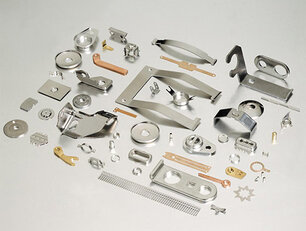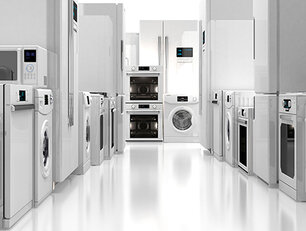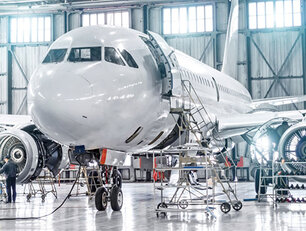
High Precision Electronic and Electrical
The high-speed precision stampings have a wide range of types, large production volumes, high precision, and complex shapes, and usually use thin sheet metal materials. Among them, electronic stampings have the various types and the most complex structures. Electronic stamping parts generally have higher precision requirements, and also require stamping material thickness is accurate, uniform, smooth surface, no spots, no flaws, no scratches, no surface cracks etc. and the material's yield strength is uniform, no obvious direction, high uniform elongation and low work hardening. Among them, heat exchanger fins, semiconductor lead frames, electrical connectors etc. are very common precision electronic stampings. Taking an electrical connector as an example, there are a wide variety of electrical connectors and a wide range of applications. Their stampings are in various shapes and generally have the following features:
(1). High reliability, because it is the electrical signal connection between subsystems, it is required to maintain reliability under harsh conditions, such as impact, vibration, stress relaxation, and environmental corrosion. Plating is usually performed to ensure corrosion resistance
(2). High precision, common civilian connector stamping parts, general blanking precision is within ± 0.03mm, bending accuracy within ± 0.05mm, and high-level blanking accuracy requirements ± 0.01mm, bending within ± 0.02mm

Household Appliances
Stamping has a very wide range of applications in large-scale industrial production. In many industrial sectors, such as automobiles, motors, electrical appliances, instruments, meters, electronics, etc. parts that use cold stamping process account for a large proportion. In addition, many parts manufactured by forging, casting, and cutting methods in the past were also increasingly replaced by strong and good-quality stampings, which greatly increased productivity and production quality, and reduced costs. Press processing mainly depends on the die and the press to complete the pressure processing. Therefore, compared with the methods of mechanical processing and plastic processing, stamping processing has many unique characteristics in terms of technology and efficiency which is embodied in the following aspects:
(1). High efficiency: the number of strokes of a typical press is several tens of times per minute, and the stroke of a high-speed press can reach several hundred times or even thousands of times per minute. It is highly efficient, easy to operate, and easy to implement automation and mechanization. It is a highly efficient processing method.
(2). Good interchangeability: the dimensional accuracy of stamping parts is ensured by the precision of the molds. Since the life of the molds is generally long, the stamping parts are of stable quality, good interchangeability, and have the feature of “the same”.
(3). A wide range of processing: by using the stamping process, it is possible to obtain thin-walled, light-weighted, and complex-shaped parts that cannot be machined or difficult to manufacture.
(4). Low cost: unlike cutting which requires the cutting of a large amount of metal, stamping consumes relatively little material, and generally does not require heating equipment. Therefore, it is an inexpensive, energy-saving, low-cost processing method.

Aerospace Industry
Sheet metal stamping process is one of the pillar processes in aerospace manufacturing industry. Sheet metal stamping parts constitute the aerodynamic shape of aircrafts and rockets, as well as various stamping parts with different sizes, complex shapes, different materials, outputs, and various types of products.
Large aircrafts have 30,000 to 50,000 sheet metal stampings, many of which are formed by using special equipments.
With the development of digital technology, information technology, automation technology, and measurement and control technology, stamping technology has achieved unprecedented development in depth and breadth underdriven by the research and development need of sheet metal stampings with new materials, new structures and high-tech content. In particular, special stamping forming technologies have made greater progress, and some special forming technologies have also achieved greater development in aero-engine applications.
The shapes of sheet metal stamping parts in the aero-engine are extremely complicated, the size is much different, the materials and variety are various, and the output is also different. Moreover, the parts on the aero-engine have high technical demand than the sheet metal parts of other industries, and the processing is more difficult. Not only does the shape and size of the parts need to meet the design technical requirements, but the extremely high reliability of the aerospace industry also requires that the parts have a reliable service life, and therefore the performance of the parts after their formation is also very strict.
Automobile
In the production of finished cars, stamping, welding, painting and assembly are collectively referred to as the four major processes for the production of cars. According to statistics, in the more than 2,000 automotive parts, the number of stamping parts of sheet metal is more than 40%, and the status of stamping process equipment in the automotive industry is evident. Today, the individual characteristics of cars make the cycle of car models replacement shorter and shorter. The change of car model is mainly reflected in the changes in the shape and structure of the car body, which is compatible with the ever-changing variety of sheet metal stamping parts.
Sheet metal stampings can be roughly divided into three categories, namely body panels, body structural parts and small and medium-sized stampings. The body panels and body structural parts are parts having functions of maintaining the body shape, such as a door, a top cover, a side panel, a trunk lid etc. which are main bodies of the sheet metal stampings. The distribution of small and medium-sized stampings in cars is relatively decentralized. For example, wheels, clutches, air conditioners for vehicles, micro-motors and other components have a large number of stampings.
Automobile covers are the most important sheet metal parts that mark the quality of automobiles. There are two main methods for its production.
A. Multiple large and heavy-duty mechanical presses equipped with automated transfers form an automated flexible press line
These machines adopt an advanced multi-link transmission system on the structure. The multi-link mechanisms that drive the inner and outer sliders are optimally designed by the computer, so that the operation of the four groups of rods is optimally synchronized, and the inner slider has a higher degree travel and return speed in one stroke, low and uniform work stroke. This feature can effectively improve the accuracy of parts and die life, reduce scrap rate. The automatic stamping production line composed of them has large tonnage, large stroke, large worktable, large tonnage air cushions, automatic loading and unloading transfer system, automatic die change system, and a full-featured touch screen monitoring system. Whole production line is with high production speed and high precision.
B. Production of large multi-station presses
The machine adopts many international advanced technologies such as electronically controlled synchronization, electronic servo three-coordinate feeding, multiple connecting rods, automatic die changing, mold protection and has various automatic functions such as remote diagnosis, remote control and network communication, suitable for cold stamping processes such as drawing, bending, blanking and forming of sheet metal parts in automobile manufacturing.
AUTOMOTIVE
Pressmach has been a partner of the automotive industry for more then 30 years.
We are familiar with the demands of the automotive industry and we deliver profitable solutions such as:
- Tryout and die-spotting of press-tooling (Tryout – hydraulic cushions)
- Decoiling lines and mechanical production presses (blanking/cutting – decoiling and recoiling lines)
- Hydrauic production presses (drawing)
- Hot forging presses
Steel Industry
Our machines are designed to meet the requirements of the steel industry.
Calamine, extreme conditions such as high temperatures, measurement in dusty environment, heavy shocks and vibrations: we are taking them in account.
- Straightening presses up to 6500t for hot and cold steel slabs (straightening)
- Decoiling lines and blanking presses. (blanking/cutting – decoiling and recoiling lines)
- Drawing presses with tooling for stretching blanks for quality-control of steel sheets.
- Test benches for fatigue testing of piping (test benches)
Aeronautic industry
The aeronautic industry desires high-tech and quality. The customers’ specifications are large and the requirements to the after sales service are exigent.
Pressmach delivers customised presses and turnkey solutions to the aeronautic industry for more than 20 years:
- Automatic blanking- and fine cutting lines for helicopter parts (blanking/cutting – decoiling and recoiling lines)
- Precise straightening presses for machined airplane structures with integration of industrial manipulators and other periphery (straightening)
- Hot and cold forging of small titanium parts (forging).
Defense
Confidentiality, high-tech, reliability, turnkey solutions, advanced technology, pre-production in the constructor’s workshop, … the requirements aren't easy.
Pressmach feels comfortable with the demands of the military industry:
- Hydraulic and mechanical presses for cupping, drawing, indenting and pressing of brass, steel and aluminium parts (drawing)
-
Hot forging: upsetting, piercing, drawing and nosing of steel parts up to 1500Kg (forging)
